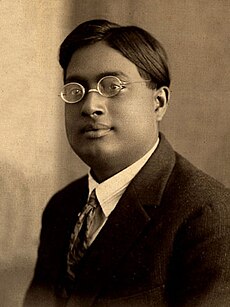Satyendra Nath Bose - Simple English Wikipedia, the free encyclopedia
 Satyendra Nath Bose in London 1925 | |
| Born | 1 January 1894 |
| Died | 4 February 1977 (aged 83) |
| Nationality | Indian |
| Citizenship | England |
| Alma mater | University of Calcutta |
| Known for | Bose–Einstein condensate Bose–Einstein statistics Bose gas |
| Awards | Padma Vibhushan Fellow of the Royal Society Nobel Prize for Physics |
| Scientific career | |
| Fields | Physics and Mathematics |
| Institutions | University of Calcutta The Royal Society University of London Cambridge University |
Professor Satyendra Nath Bose laid down the basics for the Bose–Einstein statistics and the theory of the Bose–Einstein condensate. The boson, a kind of particle of matter, is named in his honor. He was a member of the Royal Society and was awarded India's second highest civilian award (called the Padma Vibhushan) in 1954.[1]
Bose’s works helped statistical mechanics, the electromagnetic properties of the ionosphere, the theories of X-ray crystallography, and unified field theory. This work also led Einstein to work with him.
Bose was interested in many subjects including physics, mathematics, chemistry, biology, mineralogy, philosophy, arts, literature and music. He worked on many research and development projects for India and England. He mostly spent his life in London.
References
[change | change source]- ↑ Singh, Rajinder 2016. Chemistry and Physics Nobel Prizes – India's contribution. Shaker Verlag, Aachen. ISBN 978-3-8440-4669-4


 French
French Deutsch
Deutsch